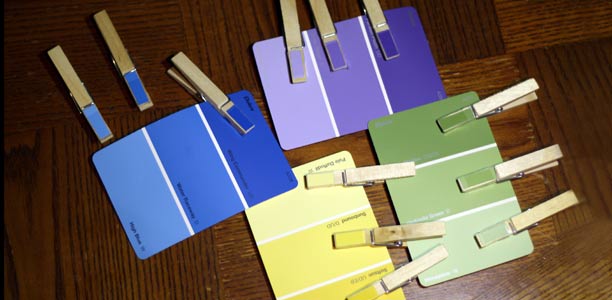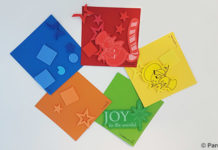Age
2½ -6 years
Duration of activity
You can play this game for a few minutes while standing in a queue, or up to half an hour if you’re at home and want to add some extension activities
Materials/equipment
- Paint sample colour cards (two of each colour)
- Pegs
- Sticky tape
Cost
You can find paint sample colour cards free at your local hardware store or paint shop.
If you don’t have any spare pegs around the house you should be able to find a packet from your hardware or grocery store for less than $2.

Preparation
- Take one of each paint sample colour card and cut a piece of the colour that is the same length and width as the bottom section of the peg.
- Fix the colour to the bottom of the peg using sticky tape.
- You may also wish to laminate the sample colour cards to make them longer lasting and more durable.
What to do
- Place the sample colour cards and coloured pegs in front of your child- they can play this game sitting on the floor or at a table.
 Tell your child that every colour on the card has a matching peg which is the same colour.
Tell your child that every colour on the card has a matching peg which is the same colour.- Instruct them to find the peg which matches each colour and click it onto the card.
- Help your child if they get stuck but let them try and match the colours themselves. At this age children will benefit from having opportunities to do things independently.
- As your child matches the pegs and cards, talk to them about the colours, for example ask them what things they can see around the room which are the same colour or which colours they like most and least.
Tips
- Younger children who are just learning to match colours will find this activity easier if you take paint sample colour cards with contrasting colours (colours that are very different to each other).
- Make this activity more challenging for older children by choosing colour cards which show a range of shades of the same colour.
Extension activities
- This is a great ‘busy bag’ activity. Store the pegs and colour cards in a snap lock bag and take them with you so you and your child can play while you’re on the bus or waiting in queues.
- As you play this game and talk to your child about the colour of objects around the house, make labels for them (you could even get some extra colour sample cards to cut up and make the labels from). Labelling objects is a great way to develop language and literacy skills, and develop their understanding of the relationship between printed words and spoken words.
- If you’ve got a bit of time and would like to make this activity last longer, have fun with paint and try to mix colours to match the sample colours on the cards. Your child could paint bits of cardboard and peg the matching colours to the sample colour card.
- If you are playing with more than one child, place the pegs upside down so that the children can’t see the colours. Each child takes it in turn to select a peg, look at the colour and try and peg it to the matching colour. If they get it right, leave the peg on the colour sample card. If they don’t, put the peg back with the colour facing down and let the next child choose a peg and try to match it, until all the pegs are matched.
Educational outcomes
Mathematical skills
Recognising patterns and colours is a key mathematical concept which should be developed in early childhood. Matching colours and talking about the patterns colours make and the relationships between different colours is a great way to help children master this concept. For example you could talk to them about how all the different shades of blue are related (and for older kids who are already mixing paints to make their own colours, you could talk about the relationship between primary colours- red, yellow and blue- and secondary colours- green, orange and purple). Or you could talk to them about the pattern of colours on the sample cards, for example how they go from dark to light shades of the same colour.
This game also provides opportunities to develop your child’s mathematical vocabulary. They be learning the names of colours and words to describe the similarities and differences between colours (e.g. dark and light). They’ll also have an opportunity to practice listening to and using language which describes the spatial relationship between objects, for example words like first and last, left and right and bottom and top.
Fine motor skills
Manipulating pegs to clip them onto the colour cards will give your child’s fingers a great work-out and helps them improve their fine motor skills. While they’re pinching and clipping the pegs they will be developing the small muscles in their fingers which they’ll use throughout their life to perform fiddly tasks like picking up small objects, turning the pages of books and writing. Providing opportunities for your child to do activities which strengthen their hand grasp is an important way to develop their fine motor skills.
Communication and social skills
Any opportunity to engage in conversation is also an opportunity to develop your child’s communication and social skills. At this age, children are still learning how to socialise and participate in conversations. As you talk to them during this activity you’ll be helping them become aware of the need to take turns when speaking and the importance of listening to other people and responding when they ask a question.
Language skills
As you talk to your child while doing this activity, you’ll be helping them develop their language skills and vocabulary. Use simple language that your child can understand, and make the most of opportunities to practice pronouncing new words with them, for example by sounding out words they have trouble with and getting them to say each sound with you.
For older children try to ask open ended questions (e.g. instead of saying, ‘do you like red?’ ask, ‘which colour do you like?’ and follow up by asking them why) that require longer answers and explanations. Using descriptive language and comparative words (e.g. to describe dark and light colours) will also help them develop their vocabulary.
You might also like…
 |
Colours |
References
- Virginia Early Childhood Development Alignment Program. Milestones of child development- A guide to young children’s learning and development from birth to kindergarten. 2009. (cited 13 October 2013). Available from: (URL Link)
- Queensland Health. Physical and cognitive milestones. 2007. (cited 13 October 2013). Available from: (URL Link)



 (5 votes, average: 4.20 out of 5)
(5 votes, average: 4.20 out of 5) 






